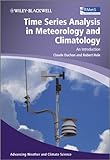Time series analysis in meteorology and climatology : an introduction / Claude Duchon, Robert Hale.
Material type: TextSeries: Advancing weather and climate sciencePublication details: Chichester, West Sussex ; Hoboken, NJ : Wiley-Blackwell, 2012.Description: 1 online resource (xi, 250 pages) : illustrationsContent type:
TextSeries: Advancing weather and climate sciencePublication details: Chichester, West Sussex ; Hoboken, NJ : Wiley-Blackwell, 2012.Description: 1 online resource (xi, 250 pages) : illustrationsContent type: - text
- computer
- online resource
- 9781119953098
- 111995309X
- 9781119953104
- 1119953103
- 9781119960980
- 1119960983
- 9781119960997
- 1119960991
- 551.501/51955
- QC874.5 .D83 2011eb
Includes bibliographical references and index.
1. Fourier Analysis -- 2. Linear Systems -- 3. Filtering Data -- 4. Autocorrelation -- 5. Lagged-Product Spectrum Analysis -- Index.
"Time Series Analysis in Meteorology and Climatology provides an accessible overview of this notoriously difficult subject. Clearly structured throughout, the authors develop sufficient theoretical foundation to understand the basis for applying various analytical methods to a time series and show clearly how to interpret the results. Taking a unique approach to the subject, the authors use a combination of theory and application to real data sets to enhance student understanding throughout the book. This book is written for those students that have a data set in the form of a time series and are confronted with the problem of how to analyse this data. Each chapter covers the various methods that can be used to carry out this analysis with coverage of the necessary theory and its application. In the theoretical section topics covered include; the mathematical origin of spectrum windows, leakage of variance and understanding spectrum windows. The applications section includes real data sets for students to analyse. Scalar variables are used for ease of understanding for example air temperatures, wind speed and precipitation. Students are encouraged to write their own computer programmes and data sets are provided to enable them to recognize quickly whether their programme is working correctly- one data set is provided with artificial data and the other with real data where the students are required to physically interpret the results of their periodgram analysis. Based on the acclaimed and long standing course at the University of Oklahoma, the book is distinct in its approach to the subject matter in that it is written specifically for readers in meteorology and climatology and uses a mix of theory and application to real data sets"-- Provided by publisher.
Print version record.


There are no comments on this title.